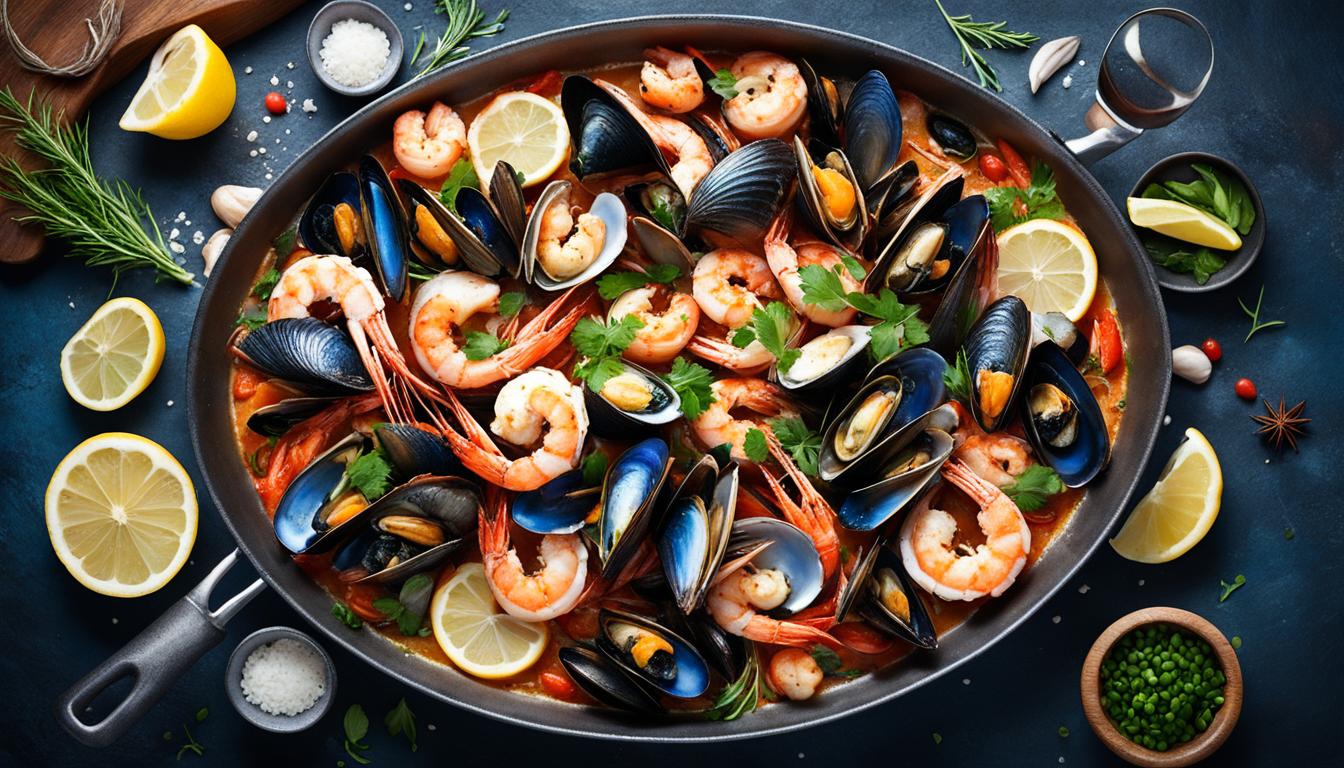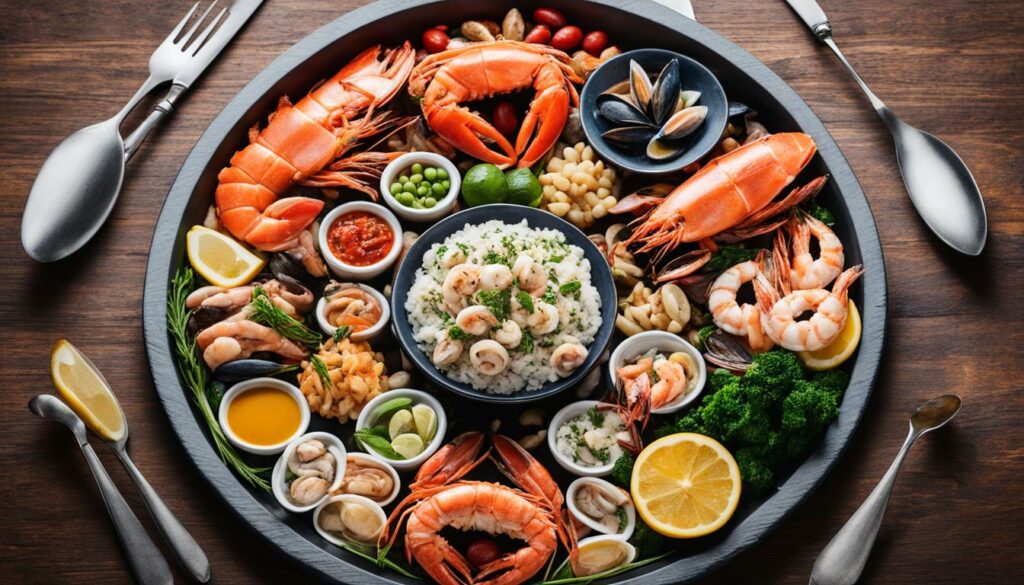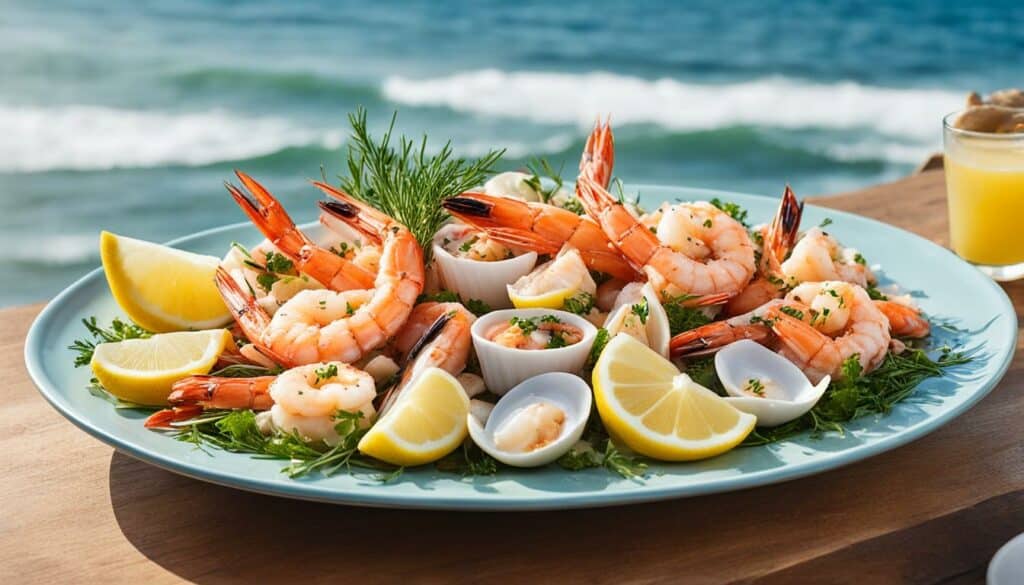
Seafood is a diverse and flavorful category of food that encompasses various types of fish and shellfish. From succulent shrimp to tender fish fillets, seafood offers a world of culinary possibilities. Not only is seafood delicious, but it is also incredibly nutritious, making it a popular choice for many. Whether you’re a seafood aficionado or just starting to explore this oceanic delight, there’s something for everyone to enjoy.
Seafood is not only tasty but also packed with essential nutrients. It is an excellent source of protein, omega-3 fatty acids, vitamins, and minerals. Incorporating seafood into your diet can contribute to heart health, brain function, and overall well-being. With its wide variety of flavors, textures, and cooking methods, seafood is a versatile ingredient that can be used to create a range of delicious dishes.
Key Takeaways:
- Seafood refers to different types of fish and shellfish.
- It offers a wide range of flavors and textures for culinary exploration.
- Seafood is highly nutritious and rich in protein, omega-3 fatty acids, vitamins, and minerals.
- Incorporating seafood into your diet can support heart health and brain function.
- There are numerous delicious seafood recipes to try.
Types of Seafood and Their Preparation
When it comes to seafood, there is a wide variety of options to choose from. Each type of seafood offers its own unique flavors and textures, making it an exciting ingredient to work with in the kitchen. Some popular seafood choices include:
- Salmon
- Tuna
- Shrimp
- Crab
- Lobster
- Scallops
Each of these seafood varieties requires different cooking techniques to bring out their best flavors. Whether you’re grilling, baking, poaching, or sautéing, the cooking method can greatly enhance the taste and texture of the seafood. It’s important to consider the characteristics of each seafood type to determine the most appropriate cooking technique:
| Seafood | Cooking Technique |
|---|---|
| Salmon | Grilling or baking |
| Tuna | Grilling or searing |
| Shrimp | Sautéing, grilling, or boiling |
| Crab | Steaming or boiling |
| Lobster | Grilling, steaming, or boiling |
| Scallops | Searing or baking |
Seasoning also plays a crucial role in enhancing the flavors of seafood dishes. Whether it’s a simple sprinkle of salt and pepper or a combination of herbs and spices, proper seasoning can elevate the taste to new heights. Furthermore, incorporating complementary ingredients such as citrus fruits, garlic, and butter can create a harmonious blend of flavors.
With these culinary techniques and a touch of creativity, you can transform these seafood varieties into delectable dishes that will impress your guests and satisfy your seafood cravings.
The Nutritional Benefits of Seafood
Seafood is not only delicious but also highly nutritious. It offers a wide range of health benefits, making it an excellent addition to any balanced diet.
One of the notable benefits of seafood is its high protein content. It serves as a great source of lean protein, which is essential for building and repairing tissues in the body. Unlike some other protein sources, seafood is low in saturated fat, making it a healthier choice for those looking to maintain a balanced diet.
Another key nutrient found in seafood is omega-3 fatty acids. These fatty acids are crucial for brain health and help reduce the risk of heart disease. Incorporating seafood into your diet can provide an adequate intake of omega-3 fatty acids and contribute to overall well-being.
Seafood is also rich in essential vitamins and minerals. It contains vitamin D, which is important for calcium absorption and bone health. Vitamin B12, found abundantly in seafood, plays a vital role in nerve function and the production of red blood cells. Additionally, seafood is a natural source of iodine, a mineral that supports thyroid function, and selenium, an antioxidant that helps protect against cell damage.
Here is a breakdown of some of the key nutrients found in seafood:
- Omega-3 fatty acids: Promote brain health and reduce the risk of heart disease.
- Vitamin D: Supports bone health and calcium absorption.
- Vitamin B12: Essential for nerve function and red blood cell production.
- Iodine: Supports thyroid function and hormone production.
- Selenium: Acts as an antioxidant and protects against cell damage.
By incorporating seafood into your diet, you can enjoy its exquisite flavors while reaping the nutritional benefits it offers.
“Seafood is a powerhouse of essential nutrients that can support various bodily functions and contribute to overall well-being.”

Exploring Seafood Recipes
Seafood recipes offer a delightful array of culinary possibilities, from simple and quick meals to elaborate and gourmet dishes. Whether you’re a seasoned chef or a novice in the kitchen, there’s a seafood recipe that will satisfy your taste buds and impress your guests. With a wide variety of seafood options available, you can create dishes that range from light and refreshing to rich and indulgent.
“Seafood recipes offer endless possibilities, enabling you to explore and celebrate the flavors of the ocean in every bite.”
Here are a few popular seafood recipes to inspire your culinary adventures:
- Grilled Salmon with Lemon Butter: A succulent piece of salmon grilled to perfection, topped with a tangy lemon butter sauce. This recipe perfectly balances the natural flavors of the fish with the brightness of citrus.
- Shrimp Scampi Pasta: Tender shrimp sautéed in garlic-infused butter, tossed with al dente pasta. This classic Italian dish is simple yet sophisticated, making it a go-to choice for seafood lovers.
- Crab Cakes: Tender lump crab meat seasoned with herbs and spices, formed into patties and pan-fried until golden brown. Serve these delicious crab cakes with a zesty remoulade sauce for a meal that oozes coastal charm.
- Lobster Bisque: A rich and creamy soup made with lobster stock, butter, cream, and a medley of aromatic herbs. Indulge in the luxurious flavors of this elegant seafood soup that will transport you to the seaside.
- Seafood Paella: A hearty Spanish dish featuring a variety of seafood, such as shrimp, clams, mussels, and squid, cooked with rice and flavored with saffron and paprika. This vibrant one-pot meal is a feast for the senses.
Feel free to experiment with different flavors, ingredients, and cooking techniques to create your own unique seafood recipes. Whether you prefer light and refreshing seafood salads, spicy seafood curries, or comforting seafood stews, there are countless possibilities to suit your taste and culinary preferences.

Seafood Recipe Table:
| Recipe | Description | Preparation Time | Difficulty Level |
|---|---|---|---|
| Grilled Salmon with Lemon Butter | A succulent piece of salmon grilled to perfection, topped with a tangy lemon butter sauce. | 20 minutes | Easy |
| Shrimp Scampi Pasta | Tender shrimp sautéed in garlic-infused butter, tossed with al dente pasta. | 30 minutes | Medium |
| Crab Cakes | Tender lump crab meat seasoned with herbs and spices, formed into patties and pan-fried until golden brown. | 40 minutes | Intermediate |
| Lobster Bisque | A rich and creamy soup made with lobster stock, butter, cream, and a medley of aromatic herbs. | 1 hour | Advanced |
| Seafood Paella | A hearty Spanish dish featuring a variety of seafood, such as shrimp, clams, mussels, and squid, cooked with rice and flavored with saffron and paprika. | 1 hour 30 minutes | Advanced |
Seafood Restaurants and Markets
If you’re not up for cooking seafood at home, there are plenty of seafood restaurants and markets where you can indulge in fresh and delicious seafood dishes. Seafood restaurants offer a variety of options, from casual fish and chips joints to upscale establishments specializing in seafood delicacies.
If you’re in the mood for some crispy battered fish with a side of golden fries, head to The Catch of the Day, a popular seafood spot known for its mouthwatering fish and chips. For a fine dining experience, make a reservation at Tides & Tastes, a renowned restaurant that serves exquisite seafood creations using locally sourced ingredients. Whether you’re craving a succulent lobster tail or a perfectly seared sea bass, these seafood restaurants will leave your taste buds tingling with delight.
When it comes to buying fresh seafood to cook at home, seafood markets offer a wide selection of options. Harbor Seafood Market is a bustling marketplace where you can find an array of fresh catches sourced directly from local fishermen. From plump shrimp and tender crab legs to whole fish and live oysters, you’ll find everything you need to whip up a seafood feast in the comfort of your own kitchen. The knowledgeable staff can even provide helpful tips and suggestions for preparing and cooking your seafood selections.
Whether you choose to dine out or shop for fresh seafood, these restaurants and markets ensure that you have access to the finest and freshest seafood options available. So, satisfy your cravings and explore the world of seafood delights offered by these wonderful establishments.
Sustainable Seafood Practices
When it comes to enjoying seafood, it’s essential to consider the sustainability of our choices as consumers. Sustainable seafood practices are designed to minimize the impact on marine ecosystems and protect the long-term availability of seafood resources. By supporting responsible fishing practices, we can ensure the preservation of our oceans and continue to enjoy the delights of sustainable seafood.
Responsible Fishing Practices
Responsible fishing practices play a crucial role in sustainable seafood. Here are some key principles:
- Avoiding Overfishing: Overfishing occurs when fish populations are depleted due to excessive harvesting. By setting catch limits and monitoring fishing activities, we can help prevent overfishing and promote healthy fish populations.
- Reducing Bycatch: Bycatch refers to the unintentional catch of non-targeted species. Responsible fishing practices aim to minimize bycatch through the use of selective fishing gear and fishing methods.
- Protecting Sensitive Habitats: Marine ecosystems are home to a diverse range of species and habitats. It is essential to protect sensitive habitats, such as coral reefs and seagrass beds, from destructive fishing practices to maintain biodiversity and ecosystem health.
Sustainable Seafood in Restaurants and Markets
Fortunately, many seafood restaurants and markets are committed to serving sustainably sourced seafood. By choosing these establishments, you can enjoy your favorite seafood dishes while supporting environmentally conscious practices. Look for certifications, such as the Marine Stewardship Council (MSC) or Aquaculture Stewardship Council (ASC), which indicate that the seafood has been responsibly harvested or farmed.
When dining out, don’t hesitate to ask your server or the restaurant staff about the sustainability practices they follow. By engaging in these conversations, we can encourage responsible seafood sourcing and contribute to a more sustainable seafood industry.
Similarly, seafood markets that prioritize sustainable seafood options provide consumers with the opportunity to purchase fresh catches with confidence. These markets often work directly with local fishermen, ensuring the traceability and quality of their seafood products.
The Importance of Sustainable Seafood
“Choosing sustainable seafood is not only about protecting the environment—it’s also about safeguarding our future food supply. By supporting responsible fishing practices, we can enjoy seafood today and ensure its availability for generations to come.”
With rising concerns about the health of our oceans and the need for responsible resource management, sustainable seafood practices are more important than ever. By making informed choices and supporting sustainable initiatives, we can preserve marine ecosystems, maintain biodiversity, and continue to enjoy the ocean’s bounty.
| Sustainable Seafood Practices | Benefits |
|---|---|
| Avoiding Overfishing | Preserves fish populations and ecosystem balance |
| Reducing Bycatch | Minimizes unintentional harm to non-target species |
| Protecting Sensitive Habitats | Preserves biodiversity and ecosystem health |
| Supporting Sustainable Seafood Restaurants and Markets | Access to responsibly sourced seafood options |
| Ensuring Future Food Supply | Preserves seafood availability for future generations |
By embracing sustainable seafood practices and responsible fishing, we can savor the flavors of the ocean while making a positive impact on the environment. Let’s choose seafood that is not only delicious but also supports the long-term health and well-being of our oceans.
Health and Environmental Considerations
When it comes to seafood, the benefits extend beyond taste. Consuming seafood as part of a balanced diet can have a positive impact on both your health and the environment. Let’s explore the health benefits of seafood and the importance of sustainable seafood practices.
The Health Benefits of Seafood
Seafood is packed with essential nutrients that are beneficial for your overall well-being. One of the key components of seafood is omega-3 fatty acids, which play a vital role in reducing inflammation, supporting brain function, and lowering the risk of heart disease. These healthy fats can help improve cognitive function, boost mood, and maintain a healthy heart.
Additionally, seafood is a low-calorie and nutrient-dense food choice, making it an excellent option for weight management. It provides high-quality protein that helps with muscle growth and repair, and it is low in saturated fat. The vitamins and minerals found in seafood, such as vitamin D, vitamin B12, iodine, and selenium, further contribute to your overall health and well-being.
Sustainable Seafood Practices
Protecting the environment is crucial for the long-term availability of seafood resources. Sustainable seafood practices focus on minimizing the impact on marine ecosystems and ensuring responsible fishing practices. By choosing sustainable seafood options, you can help preserve marine biodiversity and support the livelihoods of fishing communities.
When seafood is sourced sustainably, it means that it is harvested or farmed in a way that maintains the health of the species, protects habitats, and avoids overfishing. Sustainable seafood certifications, such as the Marine Stewardship Council (MSC) and Aquaculture Stewardship Council (ASC), help consumers identify seafood products that meet environmental standards.
Supporting sustainable seafood practices not only benefits the environment but also ensures the long-term supply of seafood for future generations to enjoy.
Image
| Health Benefits | Environmental Considerations |
|---|---|
|
|
By incorporating seafood into your diet and choosing sustainable options, you can enjoy the health benefits of seafood while making a positive impact on the environment.
https://iqnect.org/food-drink/seafood-risotto/
Conclusion
Seafood delights await those who appreciate the flavors and nutritional benefits of the ocean’s offerings. From the succulence of shrimp to the tenderness of fish, there is an abundance of options to explore and enjoy. Whether you have a passion for cooking seafood at home, prefer indulging in the delectable creations of seafood restaurants, or enjoy the experience of selecting fresh catches from seafood markets, there is something to satisfy every seafood lover’s palate.
By prioritizing sustainable seafood options and incorporating seafood into your diet, you not only get to relish the delights of the sea but also support your own health and the environment. Choosing sustainably sourced seafood contributes to responsible fishing practices, ensuring the long-term availability of seafood resources and protecting marine ecosystems. With a conscious approach to seafood consumption, you can savor the flavors of the ocean while promoting a sustainable future.
Delve into the world of seafood and unlock endless possibilities. From delectable recipes in your kitchen to memorable dining experiences and fresh catches, the choices are limitless. Experience the joy of seafood delights and discover the ocean’s treasures that can enhance both your culinary adventures and your well-being. So, dive in and embrace the bountiful flavors that fresh seafood offers!
FAQ
What is seafood?
Seafood is a diverse category of food that includes various types of fish and shellfish.
What are some common types of seafood?
Some common types of seafood include salmon, tuna, shrimp, crab, lobster, and scallops.
How should I cook seafood?
Different seafood varieties require different cooking techniques, such as grilling, baking, poaching, or sautéing.
Is seafood nutritious?
Yes, seafood is highly nutritious. It is a great source of lean protein, omega-3 fatty acids, vitamins, and minerals.
What are some popular seafood recipes?
Some popular seafood recipes include grilled salmon with lemon butter, shrimp scampi pasta, crab cakes, lobster bisque, and seafood paella.
Where can I find fresh seafood?
You can find fresh seafood at seafood restaurants and markets, which often source their seafood directly from local fishermen.
What are sustainable seafood practices?
Sustainable seafood practices aim to minimize the impact on marine ecosystems and protect the long-term availability of seafood resources.
What are the health benefits of seafood?
Seafood provides important nutrients such as omega-3 fatty acids, which can reduce the risk of heart disease and support brain function.
Why is sustainable seafood important?
Choosing sustainable seafood options helps protect and preserve marine ecosystems and ensures the availability of seafood for future generations.
